
How to ensure a convincing customer and user experience
How to build a strategy that convinces your customers? And how to ensure that the user experience (User Experience, UX) of your website is fully geared to this? Robert Cialdini’s principles of persuasion [1] are a good start to answer these questions. We investigated how these principles could be used for better, and especially more effective, customer strategy (Customer eXperience, CX) that also leads to a better user experience.
[1] Our inspiration: we recently read the article “The 6 principles of persuasion – and how to apply them to your website content” by Joseph Phillips about how persuasion can be used to embed the content of your website to seduce the user into action. He uses Robert Cialdini’s “six secrets of persuasion” to explain how persuasion works and gives examples to use it for your content.
Cialdini’s six secrets (or principles) of persuasion are:
- The principle of reciprocity: giving and taking
- The principle of commitment and consistency: staying faithful through commitment
- The principle of social proof: seeking acknowledgement and recognition
- The principle of liking: knowing what others think
- The principle of authority: trust in expertise
- The principle of scarcity: less is more
Let’s first take a look at Customer Experience and User Experience: if you work in marketing, you probably have heard of these terms before. But what exactly does it mean? Customer experience is a relatively new field in marketing and communication and focuses on the customer’s experience with an organization’s product or service. It therefore considers all channels that bring the customer and organization in contact with each other (touch points). A CX strategy is often elaborated in parts, such as the communication channels (for example a website). Nowadays, communication channels are often digital, where we no longer speak of a customer experience, but of a “User Experience” (UX). A good UX is therefore an elaboration of a CX strategy.
In this article we have taken on the challenge of mapping how Cialdini’s principles ensure a convincing CX and UX.
1. The principle of reciprocity
The principle of reciprocity revolves around giving and taking. People are generally inclined to act reciprocally. If they are given something, they will often give something back. The other way around also applies: people often give something away, in the assumption (which is supported by experience) that they get something in return.
For CX: A nice experience starts with generosity
Reciprocity also affects the experience that customers have with an organization. The idea is simple: people will expect to get something before they give. This means that a pleasant experience starts with generosity. Be generous as an organization and you will also get something back. An extra dimension here is that reciprocity also means that the relationship between the organization and the customer is equal. Nothing is expected without anything in return. In this way you build a relationship of trust and reasonableness with customers, which ensures that customers respect the organization and consider it as human. Not all organizations build on this principle, so organizations that do so can often create a surprising experience by simply giving something away.
For UX: Details are very important for a good UX
If the user experience on a website is right and users can effortlessly find what they are looking for, they will also be more likely to purchase the service or buy the product, even if competitors may be cheaper. Details are very important here, which can be the tipping point between an “ok experience” and a good experience.
An example is the waiting video on the payment page of the Coolblue website (Dutch retailer). Coolblue asks its customers to wait because they have to verify a payment. To get the customer willing to give something (namely time and patience), they give something to improve the experience: a nice video.
Coolblue gives you something to do while waiting 🙂
2. The principle of commitment and consistency
People have an almost obsessive tendency to be (and appear to be) consistent with something we have done before. If we have committed ourselves to a choice or position, a personal and interpersonal pressure is created to remain consistent with this commitment. In fact, as soon as a commitment is (made) public, the person will be forced to remain consistent with regard to that commitment. People will generally remain faithful after committing themselves and not run away quickly, provided the experience is consistent.
For CX: Keeping the customer in the ecosystem
Customer experience is all about retention and loyalty. Most (potential) customers come across many different messages and channels of an organization: from a website to an order platform and full loyalty programs. How do you get people to commit in such a diverse landscape?
Often an organization wants to have and keep the customer in the ecosystem, so that they can best offer their services and offer the customer the best experience. This works best by letting the customer make a small commitment first, such as liking a social media channel or leaving a review. The more committed your client is, the more consistent the client will come back to stay true to his or her commitment.
For UX: Lead the user through his tasks
As soon as a user has decided to provide input somewhere (for example with an order form or an online tool), the first threshold has been taken and the tendency to finish will also be greater. Many web stores respond to this by letting users, as soon as a user is in the ordering process, make small commitments and offer as few distractions as possible. A company that designs according to this principle is Typeform. The method they use to offer forms works very intuitively, but the user does not immediately see how many questions are still coming. Once the user has started, the chance to stop filling in the questions is lower according to the principle of commitment and consistency.
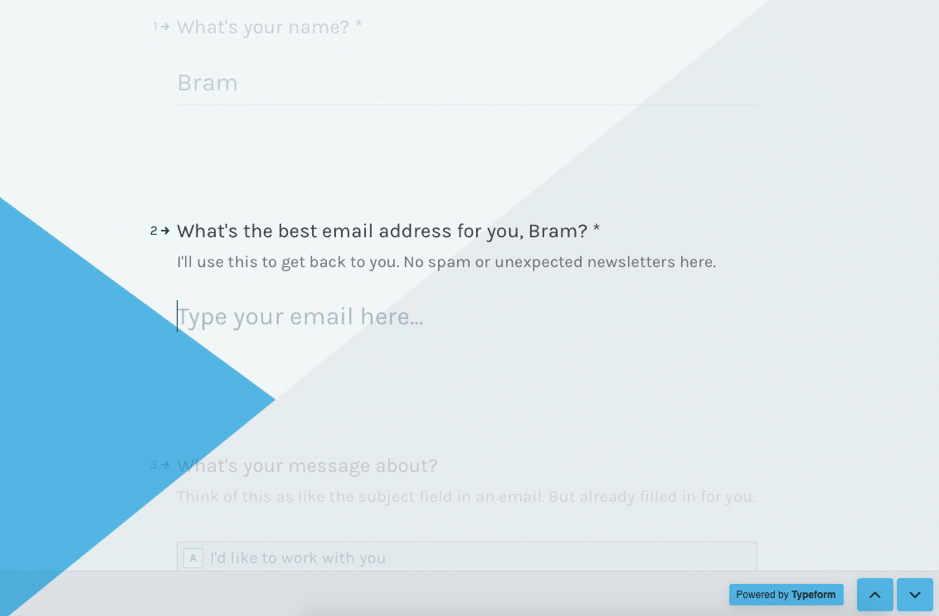
Typeform: take the user along and let them make a commitment through smart design.
3. The principle of social proof
People are social beings. We are always looking for acknowledgement and recognition as a social proof of the necessity or correctness of our actions or our thinking. We will more quickly regard an organization as an authority, as valuable or as irrelevant if the social proof is given. Social proof can be given on a micro level, in a 1 on 1 conversation, but more often and more convincing is social proof given by a large group of people. Imagine visiting a concert in a large stadium with friends and 50,000 others. Everyone thinks the concert is fantastic, but not you. Then it is very difficult to remain seated and not clap along. Your thoughts are being affected: if everyone likes it, maybe I should come around. Or: I don’t want to spoil the good atmosphere; I still stand up and expect that it will soon be fun.
For CX: Get others to be your ambassador
The experience of others is very important for how you experience something. An organization that can assure itself of social proof that it is relevant and offers a good experience, will almost have won you over. Stories from independent peers are especially important here.
Take Apple’s example. They generate social proof of the good products and the fantastic experience that they offer in all areas and for all touch points. Your friends tell about the quality of their iPhone and how nice and progressive it is. The newspaper reports on the lines that stand in front of the stores at the launch of the newest member of the Apple family. All kinds of channels stream the event online where the Apple CEO tells about their latest innovations. You are at the concert of your favorite band and everyone keeps their phone up when the artist asks to create a sea of light. Almost all of them are iPhones.


For UX: The user wants proof how the product is evaluated by others
On many online platforms, user reviews are used as a tool for others to determine if a product or service is good and should be purchased. As a company offering the product or service itself, it is important to receive good reviews. For this reason, reviews are sometimes also actively recruited or in some cases even fake reviews are purchased. If your organization is a company that resells (for example, bol.com for consumer products or the ANWB for campsites) it is especially useful to point out to the end user how good a product is, and which aspects are / are not good.

Bol.com (Dutch retailer) provides a prominent place for reviews: it is immediately clear how good others consider this product to be.
4. The principle of liking
We are more likely to make a purchase when someone we know and like recommends us to do this. While this may not even be the best product on the market; we trust the person who recommends it, so then it will probably be a good purchase. This does not only apply to people, but also to brands or organizations. If we can identify ourselves with the brand and the associated norms and values, we are more inclined to do business with that brand.
For CX: Make the experience fun for your customer
Liking is close to social evidence but has the added dimension that this is a literal recommendation from someone or a group of people. The recommendation for a product then consists of a review, for example. To build an optimal customer experience, it is important that people value the experience they have with the organization so much, and thus “like” it, that they will recommend the organization independently of the product or service. Coolblue is another good example. After users have watched the waiting movie (see reciprocity), the delivery process starts.
- The delivery van is blue and has a funny inscription
- The delivery person is on time and carries the box inside
- The box can be converted into a toy castle for the children
The next time Coolblue comes up, you say: “Great, you should order there one time. It’s quick, easy and the box is very nice!”
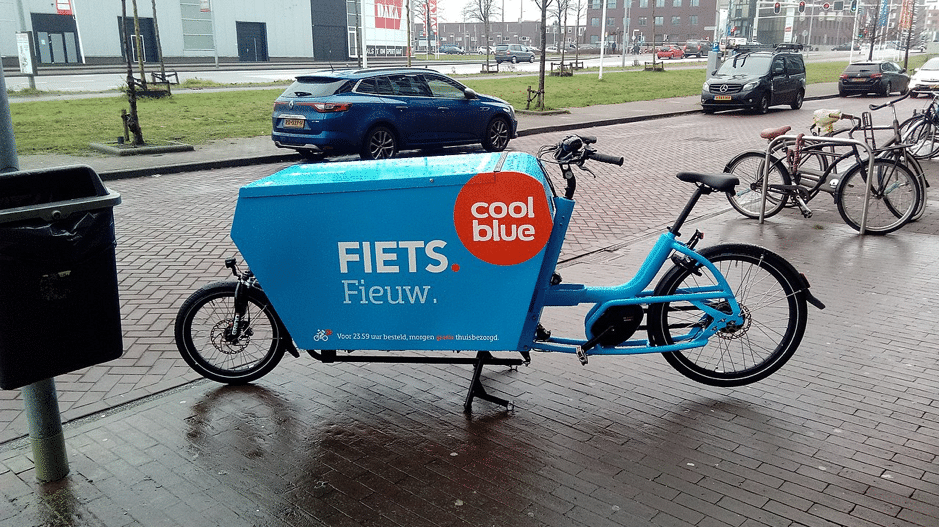
For UX: The user wants to give something back
Non-profit organizations that support charities make clear what they stand for, often using personal stories to involve people in their goal. On their websites you often see personal stories with a clear call-to-action (“Donate!”). If people can identify themselves or connect with an organization, it is wise to place the action that you want users to take in a clearly visible position.
You can see this for example in campaigns on Kickstarter; the campaigns explain what the plan is, why they do it, but the “Fund” button is always in sight so that people who are convinced can do their pledge. In exchange for their pledge they often also get a little extra. Here, the principle of reciprocity again applies.
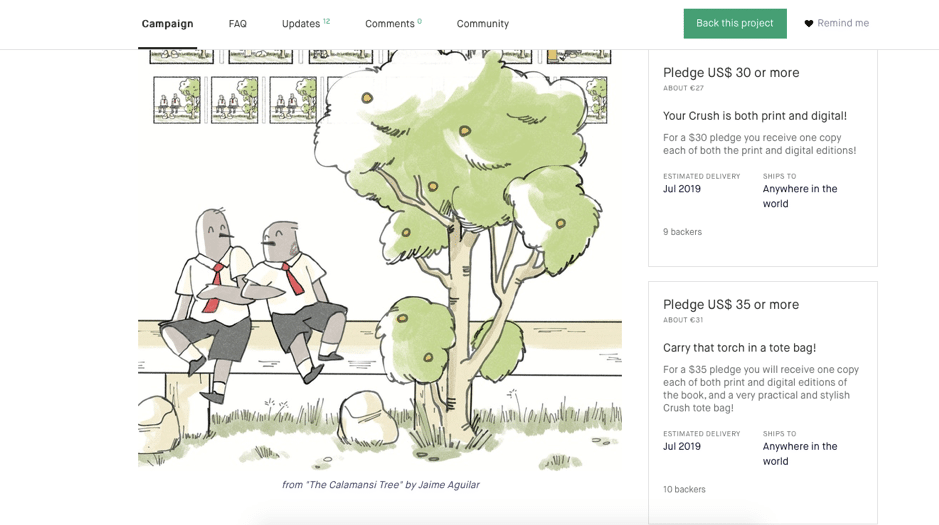
Kickstarter fully focusses on pledges.
5. The principle of authority
This principle is similar to “Liking”, but this time you do not trust someone because of your personal connection, but because of the authority / expertise of that person. Again, this also to a company / brand; a company that is dyed by wool is often taken more seriously than a company that yet has to prove itself.
For CX: Spread knowledge and become a leader
How do you become an organization with authority? A commonly used technique is to reinforce “thought leadership”. The point is to expose the knowledge that is present in the organization. Increasing the visibility of knowledge increases the authority position of the organization. This can be done in many ways, but when it comes to customer experience, the customer’s experience must be paramount. The easiest way to achieve this is to create a separate section on your website with relevant articles that highlight a knowledge area. If it is relevant content that you offer, with a nice UX, then you can really strengthen your brand. An example of a company that does this well is Feenstra (Dutch installation company). With their “Carefree Living” platform, they offer homeowners, installers and property owners’ knowledge in the field of living. In this way they show that Feenstra is more than the vans you see driving around everywhere.
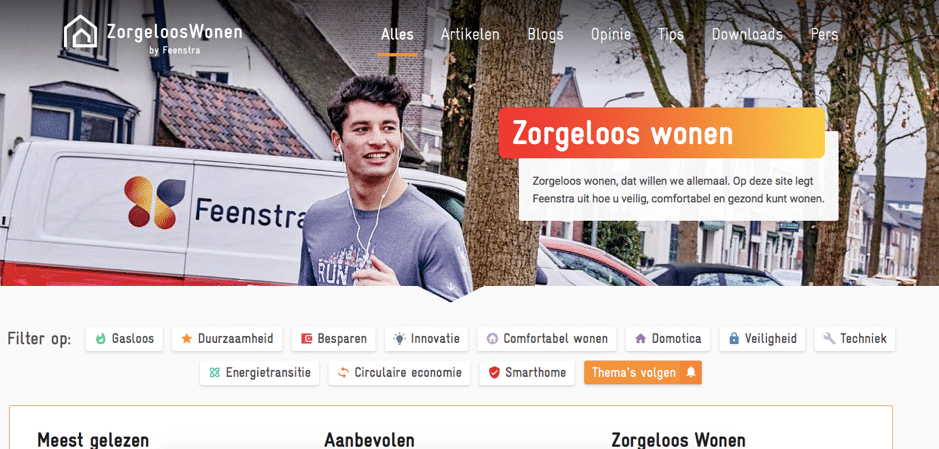
Feenstra has a complete web environment dedicated to articles.
For UX: Show users how they can use your product
In the area of user experience, it is important to make clear that the product or service has proven itself in the past and is recommended by experienced experts. An example of this is the use of case studies. At our client Signify, the B2B product catalog of their brand Philips Lighting uses case studies as much as possible to show that in past projects their products have proven to lead good results. Assigning certificates or winning awards (and propagating this) also help in gaining authority.
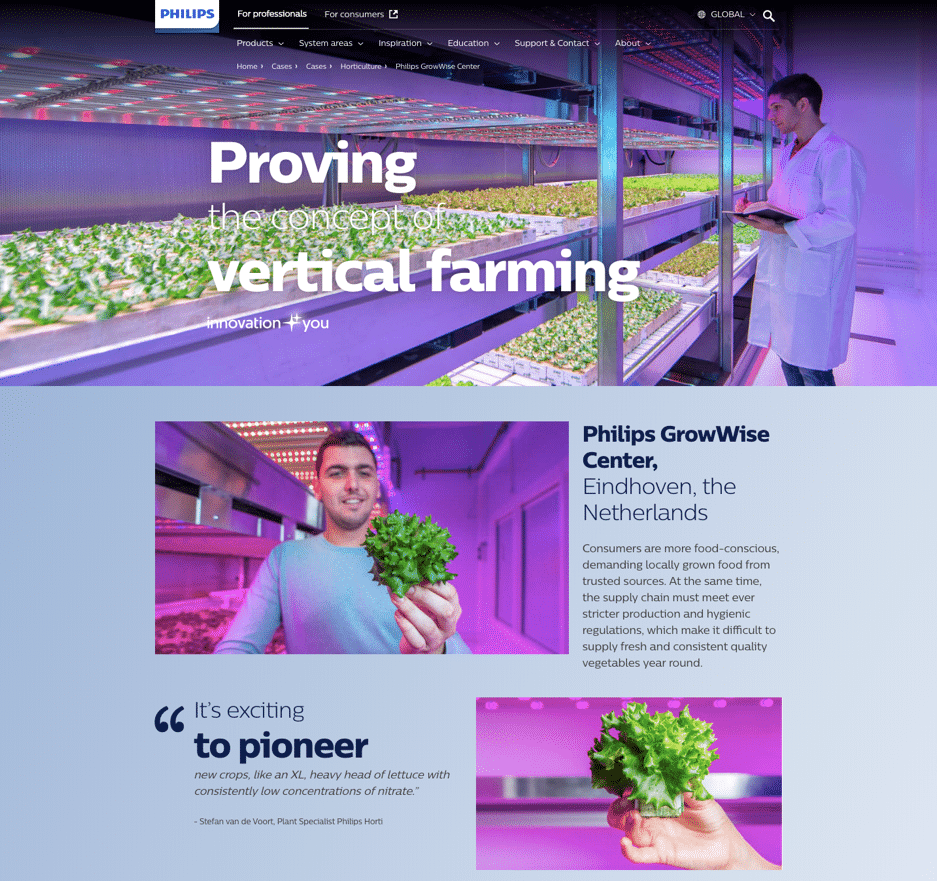
Philips Lighting inspires you with cases about the application of their products.
6. The principle of scarcity
It is common knowledge that as soon as something is scarce, it becomes more popular. By ensuring that users get the feeling that they may be missing out on something, users get the idea that they have to act quickly in order not to miss out. This is also applied by companies in their digital activities.
For CX: Play hard to get sometimes
You do not want to withhold anything from the customer. After all, a good customer experience surely starts with putting the customer at number one? Yet creating a sense of exclusivity can work well for the appeal of your company and the experience that customers have with it. Certainly in this time, where everything is always available, more and more organizations are choosing to offer their products and services only on the basis of registration, testing, randomness or invitation.
As an example: people do not just enter the website but must first register and pass an inspection. It is not clear which criteria will help you through the inspection. A crazy idea? This is exactly what “The Dead Ted Club” does. They select their visitors based on their Instagram profile. And it’s a success. People want to belong to this brand and appreciate the exclusivity and personal appreciation.
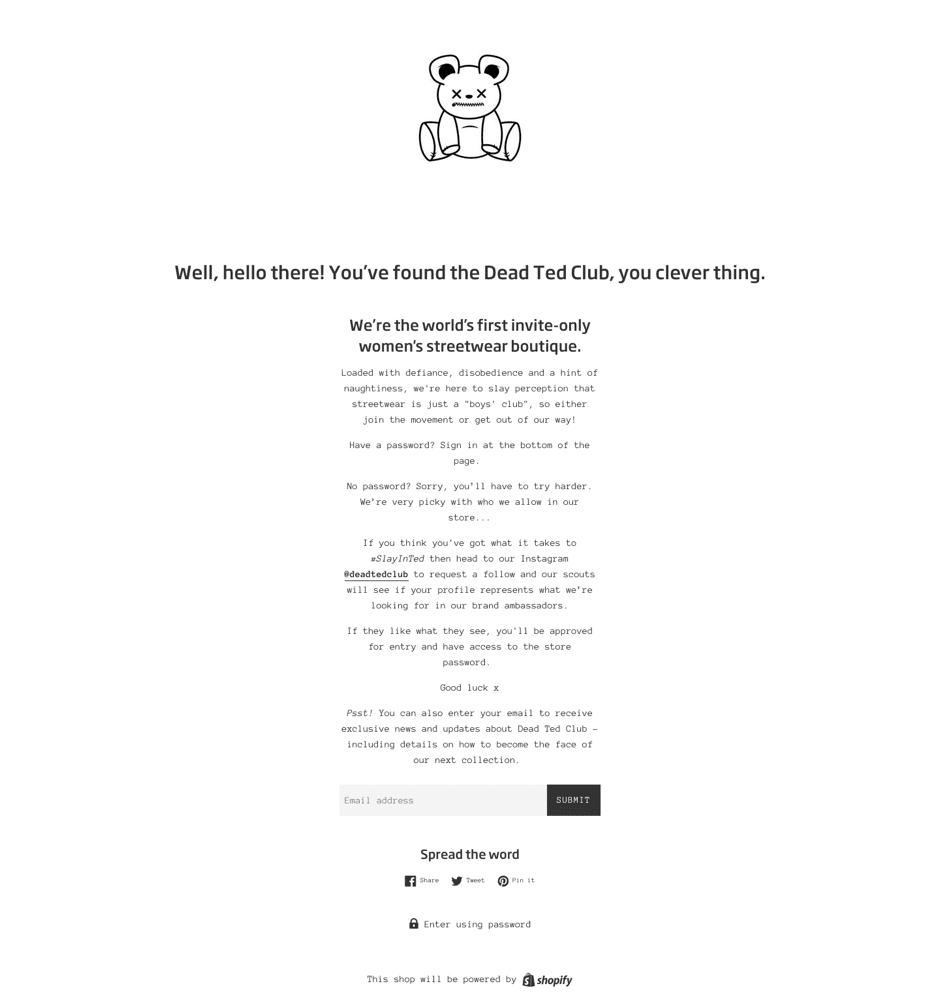
The Dead Ted Club: unfortunately we have no access…
For UX: Tell visitors that your product is scarce
An example of this principle within a website can be seen on Booking.com (website for booking hotel stays). In the overview of available hotels it is regularly indicated “only x rooms available” and that there is “a lot of demand” for this hotel for the specified dates or that other people are currently looking at that hotel. As a user you get the feeling that you have to hurry because the rooms are otherwise given away to other users.
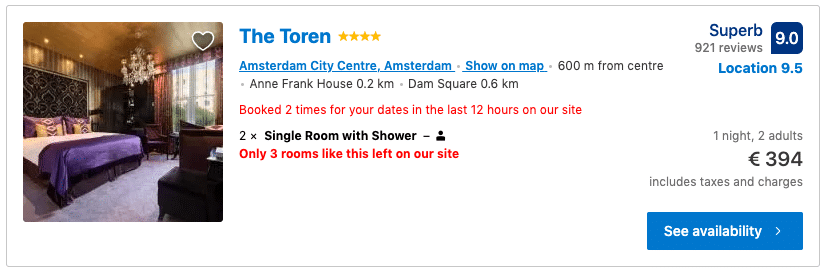
Booking.com: only 3 rooms left, I have to hurry!
The bottom line
Persuasion is something that everyone has to deal with in his work. Offering an experience that convinces your customer (or citizen, or employee) to linger longer, return more often or simply makes them happy is good for the organization and the customer himself. The 6 principles of Cialdini are useful tools for creating a customer strategy and a good user experience. With this you help your organization further and you can make a better match between your service or product and your customer.
What has to be said is that the psychological principles do not always work and that there will always be exceptions. A really good customer strategy and UX can’t be built overnight. This requires thorough research into your customer and a good design for all your channels. If after reading this blog, you think you could use some help with that: do not hesitate to call us for a short inspiration session!
 GriDD
GriDD 


